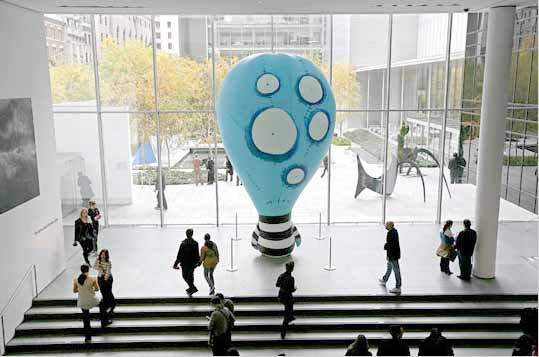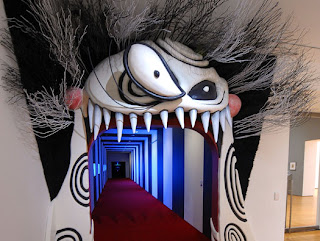MUSEUM: Museum of Modern Art
TIME: 1.5 hr
COST: $20 each
The Museum of Modern Art (MOMA) is one of the world’s greatest museums. Oh sure, there are bigger museums and a few with greater collections (but not many), but there is little doubt that MOMA has a huge influence in the art world and on the public at large. Quite simply, it’s a legend. Unfortunately, our visit this day was fraught with peril and mishap and we didn’t see as much of it as we would have liked, but we can’t blame that on the museum. Our troubles really started when a tree fell in Dobbs Ferry, but more on that later.
Much of MOMA’s fame is derived from its massive collection (over 150,000 works), which includes iconic works such as Vincent van Gogh's Starry Night, Picasso's Les Demoiselles d'Avignon, Salvador Dali's Persistence of Memory, and Andy Warhol’s Marilyn Monroe, and is considered by some to be the best collection of modern Western masterpieces in the world. But this museum doesn’t collect just paintings. MOMA has 6 different departments: Painting and Sculpture, Architecture and Design, Photography, Prints and Illustrated Books, Drawings, and Film and Media. Film and Media alone has 22,000 films and 4 million film stills.
A substantial portion of MOMA’s fame comes not from its collection, but from it’s daring. Past and present curators have held true to the philosophies behind modern art, and love to shake things up. The Architecture and Design, Film, and Photography departments were the first of their kind in any museum. Groundbreaking MOMA exhibitions have included Fantastic Art, Dada, Surrealism (1936), The Family of Man (1955), and Primitivism (1984). Right now the exhibit just finishing up is a series of performance pieces featuring, among other things, 38 completely naked men and women in various poses, including lying under a skeleton and facing each other in a doorway that visitors have to push past. Needless to say, the exhibit attracted a great deal of media attention, and not just because there were naked people in a museum. Apparently not all visitors have kept their hands to themselves.
Even MOMA’s origins are controversial, with its beginnings forged in a long lasting marital disagreement in New York’s most famous family, the Rockefellers. John D. Rockefeller Jr. was brought up a strict Baptist, with a deep respect for traditional values and a love of traditional art. His extensive collection of medieval art forms the core of the Cloisters (a huge medieval museum in Manhattan). However, his wife, Abby Aldrich Rockefeller, had completely different tastes. She loved modern art. J.D. became increasingly disturbed by the art his wife brought into their home, and as a result the allowance he gave her was quite modest in relation to the fortune he controlled. Despite her limited funds, Abbey managed to amass a large collection of prints and small paintings during the 1920’s and 30’s. One might say she eventually won their argument, as their sons Nelson and David became avid lovers of modern art, and if you ever visit Kykuit, the Rockefeller estate in Hudson Valley, you’ll find Nelson’s large collection of modern art and sculpture looking very jarring and out of place next to his father’s Neoclassical architecture and nymph fountains. The guide of the Kykuit tour I took called it a textbook case of a son’s rebellion, just done with a bit more money than most.
Due to Abby Aldrich Rockefeller’s more limited funds, MOMA began as collaboration between her and two of her friends, Lillie P. Bliss and Mary Quinn Sullivan (pictured above from left to right), over an idea Abby proposed literally over lunch. Nelson Rockefeller later remarked, "It was the perfect combination. The three women ... had the resources, the tact and the knowledge of contemporary art that the situation required. More to the point, they had the courage to advocate the cause of the modern movement in the face of widespread division, ignorance and a dark suspicion that the whole business was some sort of Bolshevik plot."
In keeping with MOMA’s revolutionary attitudes, the headline exhibit when we visited featured the works of Hollywood superstar Tim Burton, not someone you’d normally think of being exhibited in a museum (see entrance to the exhibit in picture at left). In case you’ve been living under a rock for the last three decades, Burton is famous for his dark and quirky films, featuring sensitive misfits triumphing over a world of repressive mediocrity. His biggest hits include “Pee-wee’s Big Adventure,” “Beetlejuice,” “Edward Scissorhands,” “The Nightmare Before Christmas,” and “Batman.” The exhibit featured models, costumes and set pieces from his well-known films, but also many non-film works, such as sketches, photography and even sculpture. Burton was an illustrator for Disney early in his career, and is a talented sketch artist. I particularly liked the pieces he drew during his childhood in Burbank California, like his drawing for the parks department litter campaign. Paul was fascinated by the big pink angora sweater worn by Johnny Depp in “Ed Wood.” The exhibit also featured earlier and less well known short films, like the excellent “Vincent”, depicting a young boy who fantasizes that he is his (and Burton's and Paul’s) hero Vincent Price, with Price himself providing narration.
The works all feature Burton’s particular brand of gothic macabre horror, which is funny and a little scary at the same time, and has made him famous. Both Paul and I like many of his films, but the exhibit highlighted a problem that we both have with Burton’s work. It all feels homogenous, with very little variety, and after wandering around looking at caricature after caricature with exaggerated proportions and bizarre disfigurements, we actually felt a bit bored. Burton isn’t trying to say anything new with his art, he just seems stuck in the same “weirdo makes good” rut that he’s always been in. All in all, the exhibit was fun for a while, but ultimately a bit of a let down. Paul found a humorous short video to help explain our perceptions of Burton's lack of originality.
The Burton exhibit generated a lot of fuss in the press, and was heavily advertised. It’s been held up as an example of a shift in museum attitudes. Many museums have been attempting to throw off their stodgy image and attract a younger audience. To do this, they’re hiring younger curators and embracing popular trends, like Burton. (This show was currated by the shockingly young 37-year-old Rajendra Roy, chief curator of film at MOMA.) The strategy seems to have worked in this case, as Burton visitors were relatively young, averaging in their 30’s, and the show was a blockbuster. Every weekend was completely sold out, which is where our problems began.
As we don’t live or work in Manhattan, it can be difficult for us to get into the city during the week. I managed to get a ticket for a Friday afternoon visit (one of the few left) and Paul and I arranged to be free that afternoon so we could drive into the city BEFORE rush hour. However, that afternoon a tree fell in Dobbs Ferry, knocking out power to all traffic lights in the vicinity, and Paul was stuck in a 2-hour traffic jam on his way home. From there on it was a disaster, for now we were driving into the city during rush hour (another 2 hour traffic jam). When we finally arrived at the museum, we were cranky, exhausted and extremely late for our ticketed time. Fortunately the museum is open late on Fridays and they were still willing to let us in to the exhibit. Unfortunately, the museum is open late on Fridays because that when it is free and it was completely packed. We had to fight our way through crowds to see every piece in the Burton exhibit, and when we were done with that we just couldn’t face the rest of the museum in these insane crowds. We had both seen MOMA in its entirety when we visited New York as tourists 2 years ago, so we called it a day and went home.
In conclusion, of course we would recommend MOMA for a visit; it’s in all NYC tourist guides for good reason, but try to avoid the crowds if you can.
In conclusion, of course we would recommend MOMA for a visit; it’s in all NYC tourist guides for good reason, but try to avoid the crowds if you can.









I always enjoy your humor and your "misadventures" on the way to the museums! Not being a fan of Tim Burton - he's too wierd for me - I would have enjoyed the exhibits from the 20s and 30s. Too bad you didn't get there. Maybe next time. Lynn
ReplyDeleteSo you didn't get to experience Abramovic's pieces? I'd have liked to hear your take on those.
ReplyDelete-k
Whether your prime concern is variety or taste, VaporFi is will fill your vaping needs.
ReplyDeleteWith vape juices that comes from food-grade ingredients, their vaping flavors are deliciously smooth and consistent.